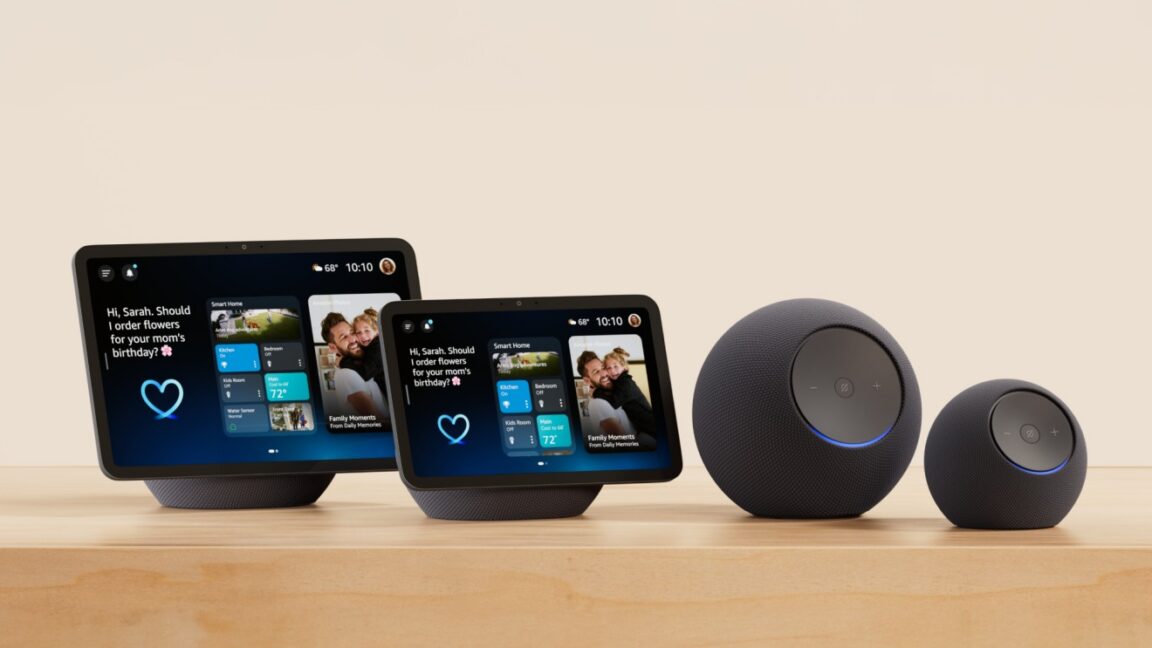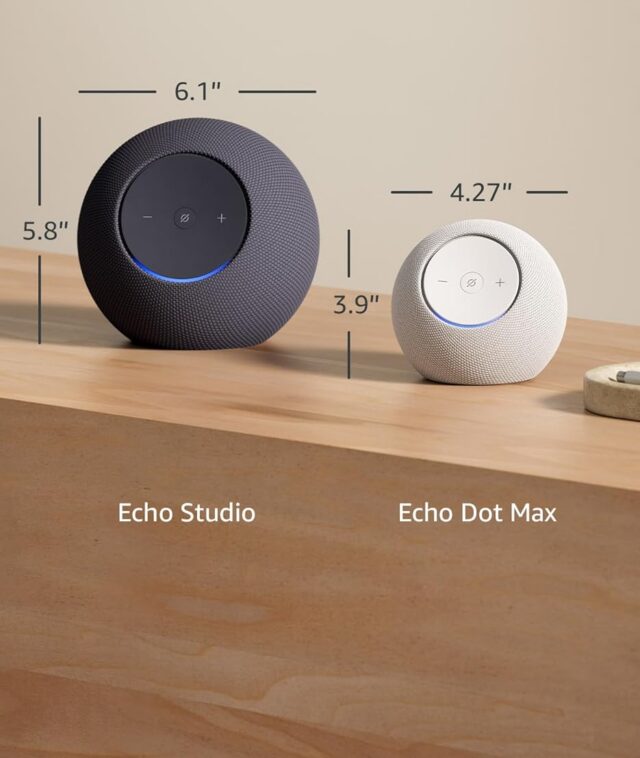
Credit: Amazon
Amazon’s voice assistant is hanging on by a thread. And that thread is generative AI—or, in Amazon’s case, Alexa+.
Amazon hasn’t had a problem getting people to buy cheap, Alexa-powered gadgets. However, the Alexa in millions of homes today doesn’t make Amazon money. It’s largely used for simple tasks unrelated to commerce, like setting timers and checking the weather. As a result, Amazon’s Devices business has reportedly been siphoning money, and the clock is ticking for Alexa to prove its worth.
Alexa+, a subscription-based generative AI service ($20 per month or included with Prime, which starts at $15/month), is supposed to solve Amazon's woes with Alexa. More conversational and powerful than the original Alexa, Alexa+ is designed to play a more central role in user transactions, enabling, in theory, Amazon to finally make money from voice assistants after 11 years.
Today, at its Devices event in New York City, Amazon unveiled new gadgets built to usher in what Amazon hopes is a new era of chatting, shopping, watching TV, and controlling smart homes with Alexa+. These devices are supposed to have the power to make Alexa+ as successful and reliable as possible.
But can Amazon convince people to pay more for new devices after establishing a reputation for cheap gadgets?
Amazon’s new devices are more expensive
Amazon announced a lot of new hardware at its Devices event (including for devices without Alexa+, like Ring and Blink cameras and Kindles). The most relevant for Alexa+ are the new Echo smart speakers and smart displays, the majority of which are more expensive than prior or similar releases.
In the speaker category is a new Echo Studio for $220. That's 10 percent more than what Amazon charged when it launched a white and software-updated version of 2019’s Echo Show ($200).
There's also a new type of Echo speaker, the Echo Dot Max. It will be $100, compared to the $50 launch price of the Echo Dot in 2022.

The new Echo Studio (left) and Echo Dot Max (right) speakers.
Credit: Amazon
Among the new displays is the $180 Echo Show 8. It's 20 percent more than its predecessor from 2021 ($150). Additionally, Amazon is releasing a new 11-inch smart display, the Echo Show 11. At $220, it’s cheaper than the 10-inch Echo Show 10 that Amazon released in 2021 ($250), marking an exception to the Alexa+ price bumps.
Similarly, Amazon’s new Fire TVs with Alexa+ have higher starting prices than the regular Alexa-based models that preceded them. The updated Fire TV Omni QLED Series ranges from $350 to $1,200 for 50- to 75-inch models. The preceding series launched in 2023 for $350 to $1,100. The new Fire TV 2-Series has a higher entry point too ($160 versus $200), though Amazon's new Fire TV Stick Select with Alexa+ is cheaper than its other 4K sticks at $40.
The new Fire TVs with Alexa+ have upgraded processors.
Credit: Amazon
Numerous factors could impact pricing, including inflation, tariffs, and production costs. Ars Technica asked Amazon about the higher prices, and a company spokesperson shared a statement saying:
The new devices reflect significant investments in better sound quality, more responsive performance, and innovative features that customers have requested.
Pricier components seem to be a driving force behind the bigger price tags. The new speakers, for instance, feature AZ3 and AZ23 Pro processors that include a new “AI Accelerator designed to run AI edge models,” according to Amazon’s announcement. The processors are supposed to enable “better conversation detection” alongside improved mics for blocking out background noise “and improving Alexa’s ability to detect the wake-word by over 50 percent.”
The AZ23 Pro also adds support for vision transformers, which can process images and more advanced language models.
Both chips use a new proprietary sensor platform. Amazon says Omnisense leverages various sensors and signals, including those from Echo Show smart displays’ cameras, as well as “audio, ultrasound, Wi-Fi radar, accelerometer, and Wi-Fi CSI.” Amazon’s announcement further explains:
This technology allows Alexa to intelligently act on various events happening in and around your home, enabling more personalized, proactive, and helpful experiences, such as delivering a reminder when a specific person walks in the room, or a proactive alert that your garage door is unlocked and it’s after 10 pm.
There are other upgrades, too. The Echo Dot Max, for example, has two speakers instead of one and claims triple the bass capability of the Echo Dot (5th Gen). And the Echo Studio is in a smaller chassis than its predecessor, which points to higher costs in delivering the same sound quality.
Amazon wants you to own multiple Alexa+ gadgets
Panos Panay, head of Amazon's Devices & Services business, at Amazon's Devices event in New York City on September 30, 2025.
Credit: Amazon
There are reasons why the devices built for running Alexa+ generally cost more. It’s a gamble for a new technology that requires a subscription, has its share of privacy concerns, and has not yet proven to be as remarkable as Amazon has claimed since 2023.
For years, Amazon devices' main draws have been affordability and simplicity. Echos gained popularity by being cheap and easy to set up around the home and use for frequently performed tasks. Fire TV devices took off as cheaper alternatives to other streaming hardware, especially to the large audience of people who care about little more than 4K, the ability to stream, and the price.
Alexa’s more devoted users have been happy to fill their houses with Amazon’s cheap gadgets. But asking people to fill their homes with more expensive devices is a bigger ask, especially for the millions of people with functioning Amazon devices (Alexa+ will work on many devices that launched with regular Alexa but should run better on the new products.) And with Alexa+ still in early access, it’s sensible for customers to be skeptical about how helpful the service will be.
Amazon would ideally like people to use multiple Alexa+ devices in their homes for a more robust experience. Its announcement today, for example, encouraged people to build Echo-centric home theaters and highlighted the ability to connect up to five Echo Studio or Echo Dot Maxes with Fire TV sticks. Amazon will eventually sell its new devices in “Alexa Home Theater bundles” as it attempts to extend Alexa’s reach in homes.
People who buy the Alexa+ devices announced today will have early access to Alexa+ out of the box. Amazon still hasn’t said when Alexa+ will be finalized, leaving a huge question mark around the more intriguing abilities that Amazon has previously demoed, like agentic AI features, and Alexa+'s effectiveness across devices.
Alexa+ is a tipping point for Amazon’s devices, its voice assistant, and voice assistants in general. Today's event revealed more about the changes Alexa+ will bring.

-
 C114 Communication Network
C114 Communication Network -
 Communication Home
Communication Home


